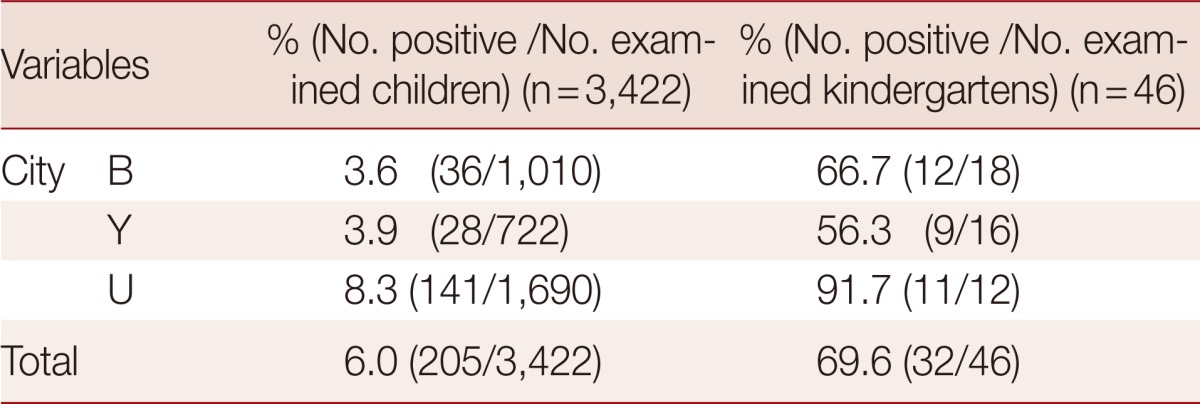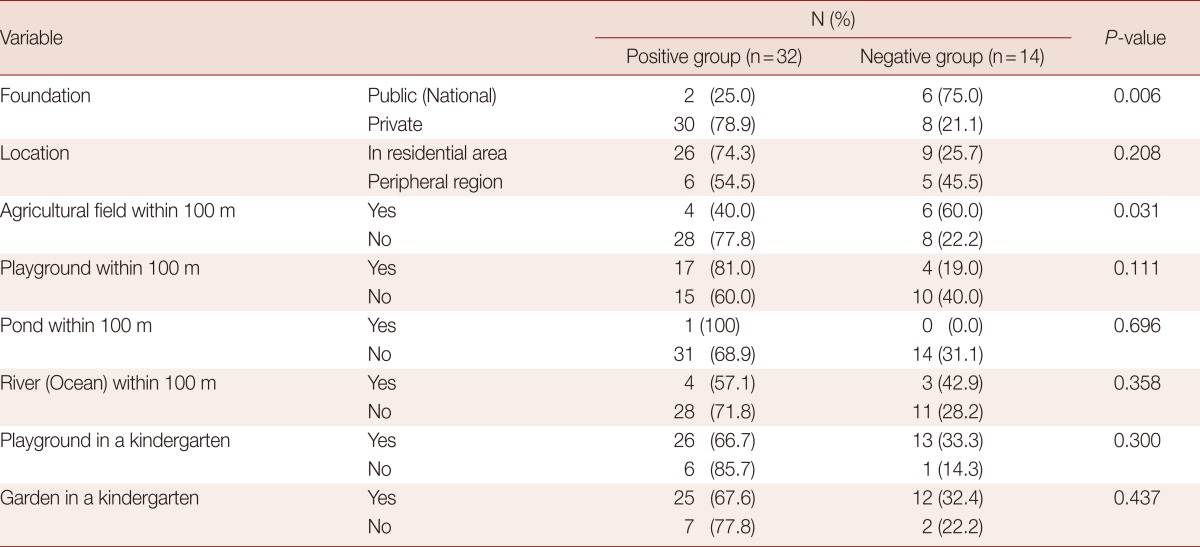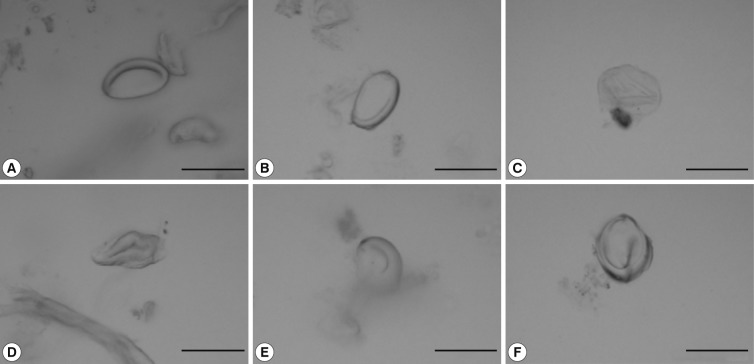Abstract
Pinworm infection can occur through contact with contaminated surfaces followed by ingestion or even through inhalation of infective eggs. We have limited information regarding environmental contamination by eggs of Enterobius vermicularis. In order to determine environmental risk factors associated with the rate of E. vermicularis infection, we investigated possible environmental risk factors using a questionnaire from 46 kindergartens in 3 different cities of the southeast area of Korea. In total, using the cellotape anal swab technique, 3,422 children were examined for E. vermicularis infection. We evaluated E. vermicularis egg of books, educational materials, toys, room door handles, dusts of window edges, desks, chairs, tables, and dusts of classrooms. The overall egg-positive rate for E. vermicularis was 6.0%, and the prevalence of enterobiasis in each kindergarten ranged between 0% and 16.9%. We found that 78.9% of egg positive kindergartens were managed by private foundations, which was significantly higher, compared with kindergartens managed by public foundations or the nation. Compared with public or national kindergartens, most private kindergartens were located in residential areas and the number of children in these areas was significantly higher. In conclusion, numbers of children in kindergartens was found to be an environmental risk factor associated with transmission of enterobiasis in Korea.
Keywords: Enterobius vermicularis, environment, risk factor, kindergarten
Infection with Enterobius vermicularis (pinworm), also known as enterobiasis, is the most common helminthic infection in the world, including developed countries [1-3]. In Korea, most helminthic parasite infections have disappeared; however, high rates of E. vermicularis infection have been reported [4-6]. Despite the strong presence of pinworm infection in preschool children of many countries, most countries have been less focused on elimination of this infection. This is because the symptoms of enterobiasis are not fatal, and most people believe that pinworm infection could be easily eradicated with 1-time medical treatment, even though that is not sufficient to kill eggs and larvae [7].
During the last several years, our team has conducted an annual survey of the positive rates of enterobiasis in different sites of the southeast area in Korea. Despite some variations in egg positive rates in each survey, enterobiasis could not be eradicated by medication alone [4,7]. In a previous study, we suggested that group medication is the best method for eradication of enterobiasis [7]. However, we observed the occurrence of new infection (6.5%) and reinfection (25.0%) at 6 months after administration of general medication (only egg positive children took anthelmintic drug). In addition, new infection (0.8%) was observed at 6 months after the group medication treatment [7]. These results indicated the possibility that objects in the kindergarten or in some other location might have been contaminated by eggs of E. vermicularis.
The most common mode of transmission of the infection is through insertion of soiled fingers or other objects, such as toys, into the mouth, or through use of contaminated objects, including bedding and towels [2]. Humans can inhale, and subsequently swallow, airborne eggs, or eggs may remain in the nose until they hatch [2]. Many studies have focused on personal hygiene and family factors affecting the prevalence of enterobiasis among children in Korea. Inadequate sanitation, poor level of parental care, no experience of taking anthelmintcs, and parents' poor knowledge regarding enterobiasis have been associated with prevalence of enterobiasis in Korea [4,5,7-9]. However, few studies regarding the environmental risk factors associated with kindergartens, where children stay most of the day, participating in various activities, including eating, playing with toys or educational materials, and so on, have been conducted. In addition, although dust containing eggs can become airborne, with wide dispersion, when dislodged from contaminated objects, no study for evaluation of the possibility of air borne transmission in Korea has been reported [10].
In this study, in order to determine environmental risk factors associated with the rate of E. vermicularis infection, we investigated 46 kindergartens in 3 different cities of the southeast area of Korea from 12 June to 11 November 2011.
For recruitment, we randomly selected 2-3 kindergartens from each of 52 administrative districts. A letter containing information about the nature, significance, and objectives of the study, copies of a questionnaire, a guide for swab examination, and a consent form were sent to directors of kindergartens. Among 114 kindergartens, 46 kindergartens agreed to participate in this study. This study was presented by the researcher to the directors of each kindergarten; the directors then sent the parent's consent form, letter of information, a questionnaire, and 2 sheets of pin-tapes to the home of each. The content of the questionnaire was the same as that used in previous studies [4,7]. In total, 4,113 parents agreed to participate in this study and 691 children for whom more than 10% of the relevant survey data were missing, or whose parents did not return the questionnaire or cellotape were excluded. Ultimately, data from 3,422 (83.2%) children were examined for E. vermicularis infection using the cellotape anal swab technique. The director of each kindergarten was asked to complete a questionnaire, including the foundation of the kindergarten (public or private), year of establishment, frequency of cleaning the classrooms and bathrooms, cleaning methods, frequency of washing toys, number of children, and total floor areas of the facilities.
For determination of egg contamination status in the environment of the kindergarten, we surveyed E. vermicularis egg contamination from books, educational materials, toys, door grips, dusts of window edges, desks, chairs, and tables using cellotape slides. In addition, we collected dust from classrooms (approximately 5×5 m) using a filtered vacuum cleaner; sterile saline was added to the collected dust for centrifugation. After centrifugation (5,000 g, 10 min), we examined the eggs under microscopy. We investigated environmental characteristics of each kindergarten, including location, agricultural field within 100 m, playground within 100 m, pond within 100 m, river or ocean within 100 m, playground in a kindergarten, and garden in a kindergarten. PASW for Windows, version 18 (SPSS, Chicago, Illinois, USA), was used for data analysis. Fisher's exact test and Spearman Rho were used for analysis of the association of infection of E. vermicularis and factors involving the environment of a kindergarten.
The overall egg positive rate for E. vermicularis was 6.0% and the prevalence of enterobiasis in each kindergarten ranged between 0% and 16.9%. The average positive rate of kindergartens located in U-city was 8.3%, which was above 2 folds, compared with those of the other cities. In addition, most of the kindergartens (91.7%) investigated in U-city are attended by children who have sufferred from enterobiasis (Table 1). In order to determine the differences in E. vermicularis infection according to characteristics of the kindergarten, we divided kindergartens into infection positive and negative groups. In this study, 78.9% of egg positive kindergartens managed by private foundations were attended by children who have suffered from enterobiasis, which was significantly higher than those of kindergartens managed by public or national foundations (Table 2). We also found that most egg positive kindergartens were managed by private foundations caring for a larger number of children than public or national kindergartens in areas containing large facilities. The class area per child of private kin-dergartens was significantly smaller, compared with that of public kindergartens, and showed a significant association with E. vermicularis egg positive rates (Table 3). Therefore, population density was a very important risk factor associated with enterobiasis. The results of our previous study indicated a close association of high population density with the possibility of E. vermicularis egg contamination in the kindergarten [4].
Table 1.
Egg positive rates of E. vermicularis infection among kindergarten children in Korea using descriptive statistics

Table 2.
Differences in E. vermicularis infection according to the characteristics of kindergartens using the Fisher's exact test

Table 3.
Correlation of E. vermicularis infection and characteristics of kindergartens using Spearman Rho

In addition, fewer children with enterobiasis have been found in kindergartens located within 100 m around an agricultural field, compared with those in the other kindergartens (Table 2). In fact, most private kindergartens were managing many children and were located in residential areas. These results indicated a close correlation of the number of children in the kindergarten and location of the kindergarten in a residential area with enterobiasis (Table 2).
However, the location of a playground, river, ocean, pond, or garden around a kindergarten showed no association with enterobiasis. In addition, frequency and methods used in cleaning rooms, toys, and bathrooms showed no correlation with enterobiasis (data not shown). Although we found no eggs of E. vermicularis from surveyed objects in the 46 kindergartens, eggs with some morphological resemblance to eggs of E. vermicularis were taken from 3 kindergartens (Fig. 1).
Fig. 1.
Resemblances of E. vermicularis eggs collected from dust in class rooms in kindergartens. (A) E. vermicularis egg was isolated from a child. (B-F) Resemblances of E. vermicularis collected from dust of 3 kindergartens in U-city. Some resemblances were collected from 1 kindergarten (B&C, D&E) (×400, Bar=50 µm).
In our study, we also evaluated many individual risk factors; the rate of infection was significantly higher in boys (χ2=10.037, P=0.002), habit of thumb-sucking (χ2=7.636, P=0.006), number of siblings (χ2=4.396, P=0.036), and medication for treatment of pinworm infection (χ2=7.120, P=0.028) (data not shown), which are known as important personal risk factors for enterobiasis [4,6,9,11,12]. However, enterobiasis was not associated with time of contact with soil material in playgrounds (data not shown). This result indicated that egg transmission of enterobiasis in Korea might occur through contact with infected colleagues, objects contaminated with eggs, and egg-containing dust rather than mediated by soil. In some developing countries, soil transmission is one of the most important modes of transmission of enterobiasis [2,10].
To evaluate air transmission of enterobiasis in kindergartens, we investigated dust of rooms in all of the kindergartens. As a result, we found no eggs of E. vermicularis from furniture, books, and toys in children's classrooms. Although we found some morphological resemblance to eggs of E. vermicularis in dust of the room, we could not confirm these as eggs of E. vermicularis. Further studies should be conducted in order to demonstrate the possibility of air transmission in kindergartens in Korea. In addition, new methods, such as PCR and western blot analysis, will be considered for use in identification of the egg-like objectss.
In conclusion, according to our results, foundation of a kindergarten, location of a kindergarten in a residential area, and numbers of children were environmental risk factors associated with enterobiasis in Korea. Although we found some possibility of air transmission of enterobiasis in Korea, more information should be gathered in order to determine the exact mode of transmission of enterobiasis in Korea.
ACKNOWLEDGMENTS
This research was supported by the Basic Science Research Program through the National Research Foundation of Korea funded by the Ministry of Education, Science and Technology, Korea (2012R1A1A1015664). This research was supported by the Korea Association of Health Promotion.
References
- 1.Rajamanickam A, Usmani A, Suri S, Dimov V. Chronic diarrhea and abdominal pain: pin the pinworm. J Hosp Med. 2009;4:137–139. doi: 10.1002/jhm.322. [DOI] [PubMed] [Google Scholar]
- 2.Roberts LS, Schmidt GD, Janovy J. Foundations of Parasitology. Boston, USA: McGraw-Hill Higher Education; 2009. [Google Scholar]
- 3.Perez Armengol C, Ariza Astolfi C, Ubeda Ontiveros JM, Guevara Benitez DC, de Rojas Alvarez M, Lozano Serrano C. Epidemiology of children's intestinal parasitism in the Guadalquivir Valley, Spain. Rev Esp Salud Publica. 1997;71:547–552. doi: 10.1590/s1135-57271997000600004. (in Spanish) [DOI] [PubMed] [Google Scholar]
- 4.Kim DH, Son HM, Kim JY, Cho MK, Park MK, Kang SY, Kim BY, Yu HS. Parents' knowledge about enterobiasis might be one of the most important risk factors for enterobiasis in children. Korean J Parasitol. 2010;48:121–126. doi: 10.3347/kjp.2010.48.2.121. [DOI] [PMC free article] [PubMed] [Google Scholar]
- 5.Kang S, Jeon HK, Eom KS, Park JK. Egg positive rate of Enterobius vermicularis among preschool children in Cheongju, Chungcheongbuk-do, Korea. Korean J Parasitol. 2006;44:247–249. doi: 10.3347/kjp.2006.44.3.247. [DOI] [PMC free article] [PubMed] [Google Scholar]
- 6.Park JH, Han ET, Kim WH, Shin EH, Guk SM, Kim JL, Chai JY. A survey of Enterobius vermicularis infection among children on western and southern coastal islands of the Republic of Korea. Korean J Parasitol. 2005;43:129–134. doi: 10.3347/kjp.2005.43.4.129. [DOI] [PMC free article] [PubMed] [Google Scholar]
- 7.Kang IS, Kim DH, An HG, Son HM, Cho MK, Park MK, Kang SA, Kim BY, Yu HS. Impact of health education on the prevalence of enterobiasis in Korean preschool students. Acta Trop. 2012;122:59–63. doi: 10.1016/j.actatropica.2011.11.017. [DOI] [PubMed] [Google Scholar]
- 8.Muge OA, Baykan Z, Artan C. Enterobiasis among preschool children: a study from Kayseri, Turkey. Jpn J Infect Dis. 2008;61:482–483. [PubMed] [Google Scholar]
- 9.Song HJ, Cho CH, Kim JS, Choi MH, Hong ST. Prevalence and risk factors for enterobiasis among preschool children in a metropolitan city in Korea. Parasitol Res. 2003;91:46–50. doi: 10.1007/s00436-003-0836-3. [DOI] [PubMed] [Google Scholar]
- 10.Hugot JP, Reinhard KJ, Gardner SL, Morand S. Human enterobiasis in evolution: origin, specificity and transmission. Parasite. 1999;6:201–208. doi: 10.1051/parasite/1999063201. [DOI] [PubMed] [Google Scholar]
- 11.Chai JY, Han ET, Shin EH, Sohn WM, Yong TS, Eom KS, Min DY, Um JY, Park MS, Hoang EH, Phommasack B, Insisiengmay B, Lee SH, Rim HJ. High prevalence of Haplorchis taichui, Phaneropsolus molenkampi, and other helminth infections among people in Khammouane province, Lao PDR. Korean J Parasitol. 2009;47:243–247. doi: 10.3347/kjp.2009.47.3.243. [DOI] [PMC free article] [PubMed] [Google Scholar]
- 12.Sung JF, Lin RS, Huang KC, Wang SY, Lu YJ. Pinworm control and risk factors of pinworm infection among primary-school children in Taiwan. Am J Trop Med Hyg. 2001;65:558–562. doi: 10.4269/ajtmh.2001.65.558. [DOI] [PubMed] [Google Scholar]



